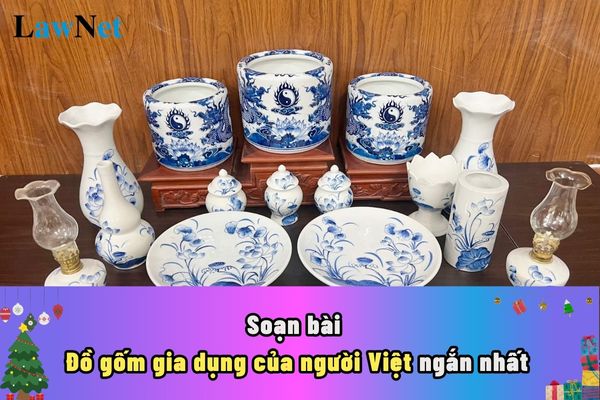Vietnam: What are the guidelines for preparing the shortest lesson "Đồ gốm gia dụng của người Việt"? What are the academic topics in the 11th-grade Literature curriculum?
What are the guidelines for preparing the shortest lesson "Đồ gốm gia dụng của người Việt"?
"Đồ gốm gia dụng của người Việt" is one of the texts that 11th-grade students will learn in the Literature curriculum as follows:
|
Guidelines for preparing the shortest lesson "Đồ gốm gia dụng của người Việt" The excerpt provides us with an insightful look into the development and diversity of household ceramics in Vietnamese history, particularly focusing on the period from the Ly dynasty to the 19th century. |
*Note: Information is for reference only./.

What are the guidelines for preparing the shortest lesson "Đồ gốm gia dụng của người Việt"? What are the academic topics in the 11th-grade Literature curriculum? (Image from Internet)
What are the objectives of the general education program for 11th-grade students in Vietnam?
Under Section 2 of the General Education Program issued with Circular 32/2018/TT-BGDDT, the objectives of the general education program for 11th-grade students in Vietnam as well as other levels are as follows:
The general education program specifies the objectives of general education, helping students master general knowledge, effectively apply the learned knowledge and skills to life, and engage in lifelong learning. It also orients students to choose professions that suit their abilities, build and develop harmonious social relationships, have personalities, character, and a rich soul life, thereby leading a meaningful life and contributing positively to the development of the country and humanity.
The primary education program helps students form and develop basic elements that lay the foundation for harmonious physical and mental growth, qualities and competencies; with a central focus on educating about personal values, family, community, and essential habits and behaviors in study and daily life.
The lower secondary education program helps students develop the qualities and competencies formed and developed at the primary level, self-adjust in accordance with common social norms, apply active learning methods to complete foundational knowledge and skills, have initial awareness about various professions, and career orientation to continue higher education, vocational training, or join the workforce.
The upper secondary education program helps students continue to develop the necessary qualities and competencies for workers, citizen consciousness and character, self-study ability, lifelong learning consciousness, and career choices suitable to their abilities, interests, conditions, and circumstances to further their education, vocational training, or join the workforce, with the ability to adapt to changes in the context of globalization and the new industrial revolution.
What are the academic topics in the 11th-grade Literature curriculum in Vietnam?
Under sub-section 2 Section 5 of the General Education Program for Literature issued with Circular 32/2018/TT-BGDDT, the academic topics in the 11th-grade Literature curriculum in Vietnam include:
| Required outcomes | Content |
| Topic 10.1. RESEARCH AND REPORT ON A FOLK LITERATURE MATTER | |
| - Understand the requirements and methods to research a folk literature matter. | 1. Requirements and methods to research a folk literature matter |
| - Know how to write a research report. | 2. How to write a research report |
| - Apply some knowledge from the Topic to reading comprehension and writing about folk literature. | 3. Some topics that can be researched in folk literature |
| - Know how to present a folk literature matter. | 4. Requirements for organizing a presentation on a folk literature matter |
| Topic 10.2. DRAMATIZING LITERARY WORKS | |
| - Understand what dramatizing literary works entails. | 1. Literary works and dramatizing literary works |
| - Know how to carry out the dramatization of a literary work. | 2. Procedure to dramatize a literary work |
| - Be proficient in acting and performing. | 3. Techniques for role-play, acting, and dramatizing literary works |
| - Recognize the difference between language in literary texts and language in theatrical texts. | 4. Language in literary texts and language (multimodal) in theatrical texts |
| Topic 10.3. READING, WRITING, AND INTRODUCING A POETRY COLLECTION, A SHORT STORY COLLECTION, OR A NOVEL | |
| - Know how to read a poetry collection, a short story collection, a novel. | 1. Method of reading a poetry collection, a short story collection, a novel |
| - Know how to write an introduction for a poetry collection, a short story collection, a novel. | 2. How to write an introduction for a poetry collection, a short story collection, a novel |
| - Know how to present and introduce a poetry collection, a short story collection, a novel. | 3. Requirements for presenting and introducing a poetry collection, a short story collection, a novel |

